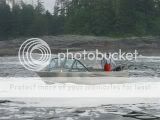More BS, agreed, but I noticed a slightly more expanded story than Cuba Libre quoted appeared in the Sun on November 13.
Highlighted (embolded) a couple of points.
First Nations (Sto-lo?) bought off by being made the prime contractors? Don't blame them for seizing the economic opportunity, but seems like the Province is taking out a possible critic.
Also doubt that flood prevention is the only goal, and wish DFO would live up to its mandate. I'm not an expert, but if the removal does not and will not affect the fisheries, DFO should make a positive statement, or, if it is detrimental, take action to arrest the mining.
From the Vancouver Sun, November 13/09
"The B.C. government plans to resume gravel removal on the lower Fraser River this winter despite the findings of a federal auditor-general report that concluded previous removals killed up to 2.25 million young pink salmon, occurred without full authorization and did little to reduce the flood risk.
Dwayne Meredith, manager of strategic mitigation programs with Emergency Management B.C., said he expects gravel to be extracted in January to March while B.C. and Ottawa negotiate a new long-term agreement.
"We have every anticipation of removing gravel," he said in an interview from Victoria.
Meredith said specific sites have not yet been decided, but confirmed that first nations would be responsible for the gravel removal and arranging their own contractors for the work.
Rebecca Reid, regional director of habitat and enhancement for federal fisheries, said in Vancouver that the new agreement being negotiated with the province will address issues such as monitoring of gravel removal, consulting with first nations and communications between the two senior governments.
A five-year federal-provincial agreement signed in 2004 provided for the annual removal of 500,000 cubic metres from Hope to Mission during the first two years and 420,000 cubic metres per year in the last three years, with a one-year extension to Mar. 31, 2010, while a new long-term agreement is negotiated.
The actual removals fell short of the maximum allowable: 149,820 cubic metres in 2005, 273,000 in 2006, 25,000 in 2007, 400,100 in 2008, and 293,615 in 2009.
A coalition known as Fraser River Gravel Removal Stewardship Committee urged Ottawa on Thursday not to conclude any long-term agreements with B.C. pending the results of a commission of inquiry, announced by the federal Conservatives last week, into the collapse of Fraser River sockeye runs.
Committee spokesman Otto Langer, a former federal fisheries biologist, lamented that Ottawa once prosecuted people for gravel removal but now promotes the activity without obeying its own no-net-less-loss habitat policy.
Meredith insisted gravel is being removed to reduce flood risk on the lower Fraser and not to access aggregate to fuel construction in the region.
"This is all about public safety," he said. "All the gravel removal ... is under the flood mandate. I definitely see and understand the benefits.
"You can only build the dikes so high before ... it just becomes engineeringly impossible to do so any further."
Of past fish deaths blamed on gravel removal, he said: "If you have one unfortunate event occurring in the past it doesn't mean it will continue in the future. We move forward with the best information."
The report last spring by the Commissioner of the Environment and Sustainable Development on behalf of the auditor-general found that in 2006 improper construction of a causeway for accessing gravel at Big Bar, near the Agassiz-Rosedale Bridge, resulted in a side channel drying up, exposing salmon nests and resulting in the loss of up to 2.25 million young pink salmon.
The report found that "adequate information on fish stocks to assess project impacts was lacking for a number of the ministerial authorizations for gravel removal."
It also found evidence of excessive removal of gravel, destruction of habitat and mining outside the approved area -- events that Ottawa failed to prosecute.
John Werring, an aquatic habitat specialist with the David Suzuki Foundation, called on the province to be more open about its gravel extraction plans. He added that while some site-specific removals may be helpful in reducing the flood threat, that's not been the case to date in a program mainly interested in aggregate.
"It's for aggregate reasons, I'm absolutely convinced of it," said Werring.
The gravel extraction operation is also being criticized for allowing temporary bridge supports to remain in the river as a way of accessing gravel at Spring Bar, between Hope and Agassiz near Seabird Island.
Meredith said the pilings, installed in January 2007, have the required permits from Transport Canada under the federal Navigable Waters Protection Act.
When The Vancouver Sun accompanied a federal fisheries enforcement helicopter patrol last year, an aluminum fishing boat could be seen crushed and wrapped around the upstream side of one of the supports.
Werring said he believes the boat belonged to aboriginal fishermen and that no one was injured in the incident, but said he continues to have concerns about the dangers posed by the structure.


